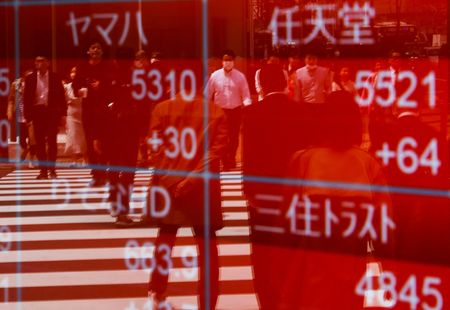
By Jamie McGeever
(Reuters) – A look at the day ahead in Asian markets from Jamie McGeever.
Asian markets are looking for a positive end to the week on Friday following a solid rally on Wall Street the day before, as the U.S. debt ceiling vote passed its first congressional hurdle and hopes rose that the U.S. economy will achieve a ‘soft landing’.
South Korean inflation for May is the main regional economic indicator on the calendar, and the won could also get a jolt from revised first quarter GDP growth figures. Otherwise, Friday’s impetus looks set to come from Thursday’s ‘Goldilocks’ trading on U.S. markets.
A batch of indicators suggested U.S. inflationary pressures are cooling, which could allow the Fed to pause its rate-hiking cycle later this month, while other data showed the labor market remains strong.
A win-win for risky assets.
A weaker dollar and lower Treasury yields also helped fuel the surge in U.S. stocks, with the Nasdaq and tech sector once again the highest fliers. The Nasdaq is on track for a sixth straight weekly gain, which would be its best run since 2019.
Contrast that with China, where purchasing managers index reports for May were mixed, broader economic data is weak, the central bank is expected to ease policy soon, and investors are pulling their money out of the country.
Little wonder the yuan is sliding further below 7.00 per dollar to fresh 2023 lows on a near daily basis.
The dollar’s strength against the yuan on Thursday is telling, because it was not replicated across Asia. The Indian rupee registered its biggest rise in three months after PMI data showed factory activity in India grew last month at the fastest pace in two and a half years.
This follows Wednesday’s surprisingly strong GDP data.
The Australian dollar had its best day in six weeks, and the Japanese yen rose for a fourth consecutive session – its longest winning streak since November.
Global markets on Friday will take their cue from the U.S. employment report for May but its release comes after Asian markets close, leaving Korean CPI and revised GDP as potentially the main market-moving economic indicators.
Annual inflation is expected to ease to 3.30% from 3.70% in April, which would be the lowest since October 2021.
Here are three key developments that could provide more direction to markets on Friday:
– South Korea CPI inflation (May)
– South Korea GDP (Q1, revised)
– Japan monetary base (May)
(By Jamie McGeever)







